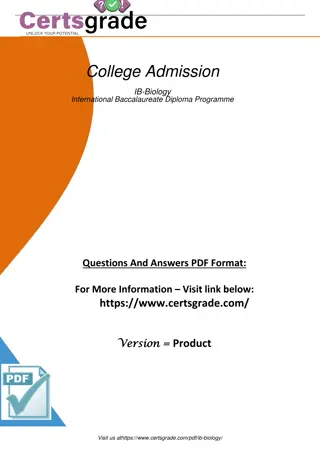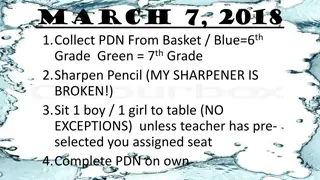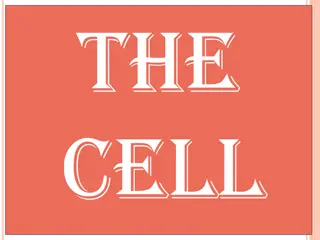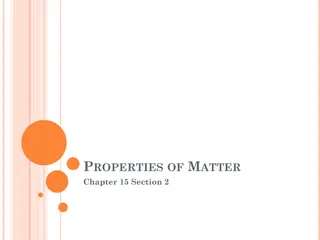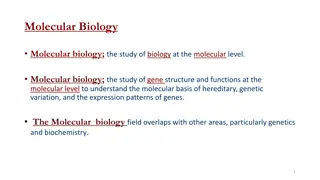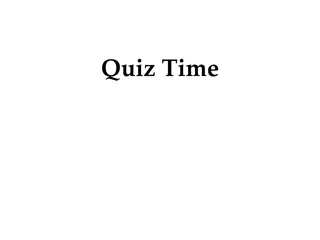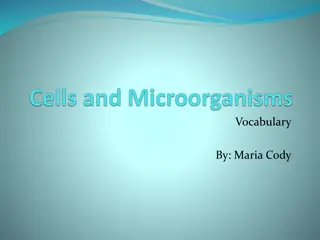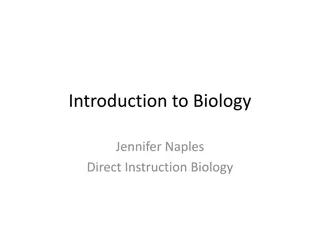Introduction to Properties of Life and Levels of Organization in Biology
Properties of Life cover aspects such as order, sensitivity to stimuli, reproduction, growth, development, regulation, homeostasis, and energy processing. In addition, the levels of organization in living things range from atoms and molecules to ecosystems and the biosphere. Understanding these fundamental concepts is crucial in biology.
Download Presentation

Please find below an Image/Link to download the presentation.
The content on the website is provided AS IS for your information and personal use only. It may not be sold, licensed, or shared on other websites without obtaining consent from the author. Download presentation by click this link. If you encounter any issues during the download, it is possible that the publisher has removed the file from their server.
E N D
Presentation Transcript
Biology II for Non-Majors Introduction to Biology
Properties of Life- Order and Sensitivity to Stimuli Order: Organisms are highly organized and coordinated structures that consist of one or more cells Simple, single-celled organisms are complex- atoms, molecules, organelles, etc. Multicellular organisms- tissues work to create organs Sensitivity/Response to Stimuli: Organisms respond to diverse stimuli Movement toward stimulus is positive, while away is negative
Properties of Life- Reproduction and Growth, Development, and Regulation Reproduction Single-celled organisms reproduce duplicating DNA then dividing it equally as cell divides to two new cells Multicellular organisms produce germline cells that will form Genes containing DNA passed to organism s offspring Growth Development Organisms grow/develop following instructions coded for by genes Genes provide instructions to direct cellular growth Regulation Coordinate internal functions, respond to stimuli, and cope with stress
Properties of Life- Homeostasis and Energy Processing Homeostasis Conditions such as correct temp., pH, concentration of diverse chemicals, etc. change from one moment to next The ability of organism to maintain constant internal conditions Energy Processing All organisms use source of energy for metabolic activities Organisms capture energy from sun and convert to chemical energy (photosynthesis) or they use chemical energy in molecules they take in as food (cellular respiration)
Levels of Organization of Living Things Atom is smallest and most fundamental unit of matter- contains nucleus Molecule- two or more atoms joined together Macromolecules- large molecules that are formed by polymerization (DNA) Organelles- small structures that exist within cells Cell- smallest fundamental unit of structure and function Community- sum of populations Ecosystem- all living things Prokaryotes- single-celled organisms without membrane- bound nucleus Eukaryotes do have membrane- bound organelles and nucleus Tissue- groups of similar cells with similar/related functions Organs- collections of tissues grouped together Population- individuals of species living within specific area Biosphere- collection of ecosystems
The History of Biology Roots in medicine and natural history Ayurveda Ancient Egyptian medicine Aristotle and Galen from Greco-Roman days 18thand 19thcenturies saw the development of biological disciplines like botany and zoology Cell theory Early principles of genetics Darwin s theory of evolution 20thcentury New disciplines like genetics, cellular biology, molecular biology Modern biology combines organismal biology with molecular techniques Genomics and proteomics Interactions between genes and environment Population genetics
The Diversity of Life Biodiversity refers to the variety of life and its processes including variety of living organisms, genetic differences, and communities where they occur 1.9 million species alive today divided into six kingdoms Provides us with our food and many medicines/industrial products Provides and maintains wide array of ecological services - clean air and water, soil, food, and shelter
The Branches of Biology Molecular/biochemistry study biological processes at molecular and chemical level (DNA/RNA/microorganisms) Microbiology- study of structure and function of single-celled organisms Also physiologists, ecologists, geneticists, forensic scientists, and others Neurobiology- studies biology of nervous system Paleontology- uses fossils to study life s history Development of technology continues- allows biologists to continue to understand history of life
Scientific Inquiry Curiosity and inquiry are driving forces for development of science- scientists seek to understand world and way it operates Inductive reasoning- form of logical thinking that uses related observations to arrive at general conclusion Deductive reasoning- uses general principle or law to forecast specific results Descriptive science- observe, explore, and discover Hypothesis-based science- has specific question and potential answer
Hypothesis Testing Scientific method- set up inductive methods for scientific inquiry Begins with observation that leads to a question Hypothesis- suggested explanation that can be tested After hypothesis, prediction can be made Must be testable to ensure it is valid Should also be falsifiable- can be disproven through experiment
Basic and Applied Science Basic science- seeks to expand knowledge regardless of short-term application of that knowledge Not focused on developing product or service- knowledge for knowledge s sake is main purpose Applied science- aims to use science to solve real-world problems Some believe it is useful Work together to solve practical problems- after discovery of DNA Another link is Human Genome Project
Reporting Scientific Work Scientists must share findings for other researchers to expand upon Communication and collaboration within and between sub disciplines of science are key to advancement Peer-reviewed articles- specific papers that are reviewed by a scientist s colleagues, or peers Many journals and press don t use peer- review system Results of any studies published without peer review are not reliable and shouldn t form basis for other work
Summary: The Process of Science Identify the shared characteristics of the natural sciences Understand the process of scientific inquiry Compare inductive reasoning with deductive reasoning Describe the goals of basic science and applied science Biology is the science that studies living organisms and their interactions Hypothesis is a tentative explanation for an observation Scientific Theory- well-tested explanation for set of observations Scientific Law- description of the behavior of an aspect of nature Summary of science- main goal is to expand knowledge without any expectation of short-term
Quick Review What are the properties of life? Can you correctly order the levels of organization of living things? Please explain the diversity of life What is the purpose of phylogenetic trees? Are you able to explain how relationships are indicated by the binomial naming system? What are the main branches of biology? Can you identify the shared circumstances of the natural sciences? Do you understand the process of scientific inquiry? Are you able to compare inductive reasoning with deductive reasoning? What are the goals of basic science and applied science?




![❤[READ]❤ Cosmic Biology: How Life Could Evolve on Other Worlds (Springer Praxis](/thumb/21556/read-cosmic-biology-how-life-could-evolve-on-other-worlds-springer-praxis.jpg)

